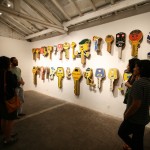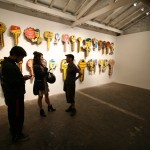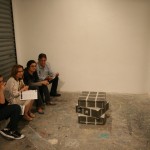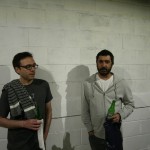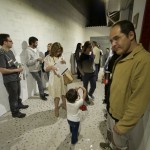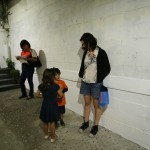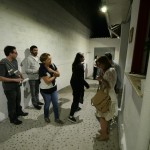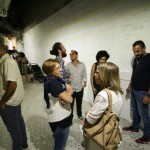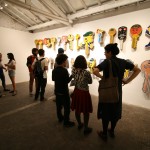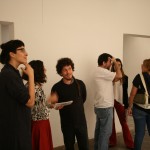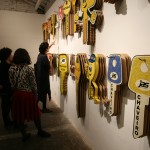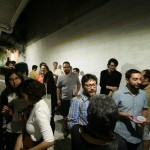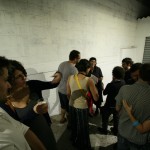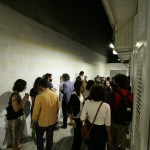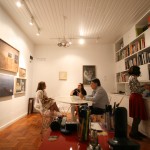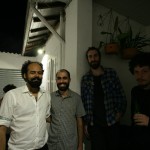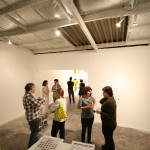Faça aqui | Ana Luiza Dias Batista
Faça aqui
{English below}
A palavra certa não pode ser um adjetivo. Melhor se for um substantivo. Mas, dependendo, advérbio serve. Precisamente. Ou seja, conforme o tempo dos relógios ingleses (ou seriam relógios suíços, usados por ingleses?). O tempo dos que não se atrasam, nem se adiantam, permanecendo sempre em cima da hora.
Chegamos à exposição “Faça aqui”, de Ana Luiza Dias Batista, no exato momento em que vemos o miolo da fechadura girar. Não vemos a chave, só o movimento circular da engrenagem do miolo. Algo como um eterno abrir, como se o gesto de girar a chave não fosse uma ação que só faz sentido quando precisamos transpor uma barreira e adentrar um recinto. Como se pudéssemos falar: “Ontem passei a tarde girando as chaves, perdi a noção do tempo”.
Como, aliás, dizemos mesmo em outras situações, como quando estamos jogando: ficamos encaixando, combinando os iguais, fazendo sequências, movimentando peças, dados, cartas ou blocos coloridos. Para quê? Para que eles sumam. Para que eles se alinhem. Para que os lados fiquem iguais. O fim do jogo acontece quando os peões da mesma cor entram na casa de chegada, quando não sobram mais peças na mesa, no tabuleiro, nas mãos. Ou quando “resta um”, como no solitário jogo de mesmo nome, que a artista constrói diretamente nas paredes do espaço expositivo, usando apenas materiais de montagem: buchas e parafusos, relacionando a construção da “obra de arte” a esse tipo de atividade bastante específica que é o jogo, ou seu irmão, o passatempo.
O cofre-cubo-mágico, outra peça em exposição, também faz referência a um jogo. Novamente um desses que se joga sozinho. As faces do cofre, quadradas, correspondem às do cubo-mágico e foram cortadas em três partes iguais, na horizontal e na vertical. As linhas, que desenham essas nove placas em cada face, já insinuam sua independência do conjunto e sugerem que podem ser movidas separadamente. Um, apenas um, movimento de rotação do bloco inferior, faria o cubo-cofre encaixar perfeitamente. A esse movimento corresponde o fim do jogo, a abertura do cofre, o giro da chave que abre a porta. Um clique. Um som diferente, que romperia a uniformidade do tempo passando, homogêneo, cíclico, sempre a recomeçar. Tempo que é reiterado na instalação sonora, no hall de entrada da exposição que, lembra o início de uma nova partida de um jogo eletrônico, ou um trecho (de suspense, de mistério) da trilha sonora de um desenho animado, sinaliza a entrada do espectador em campo: “Está valendo”.
Mas a exposição começa antes, ainda fora do espaço expositivo, na calçada de fora do Ateliê397 onde a artista incrusta chaves no cimento, imitando um chão de chaveiro. O tapete de chaves invade o chão de dentro, ao longo corredor que acompanha a casa, abandonando ali, definitivamente, qualquer suposta função de sinalização comercial. As chaves que abrem a porta do espaço estão entre as que foram espalhadas na calçada: visíveis, mas indecifráveis e, de qualquer maneira, inacessíveis. O fato de não serem manipuláveis – estão presas no chão com cimento – contrasta com o nome da exposição, “Faça aqui”, que convidaria a algum tipo de atividade.
Na exposição, o convite à ação é seguido pela impossibilidade, inutilidade, falta de necessidade de agir: as chaves estão presas do lado de fora e, mesmo assim, o miolo gira do lado de dentro. Os jogos estão expostos, mas não para serem jogados – mesmo se fossem, essa ação seria meramente reiterativa, um movimento já prescrito. Algo dessa ordem acontece também com as chaves gigantes, recolhidas pela artista em diversos chaveiros da cidade. No interior da sala expositiva, elas não operam mais como placas que anunciam um serviço. Sua disposição – penduradas na parede, alinhadas – sugere que as vejamos como chaves novas esperando para serem gravadas. Ao colocar essas chaves “de Itu” ou “do carro zero km sorteado em algum programa de auditório” na situação real de chaveiro, no contexto da vida cotidiana, o efeito que produz é algo entre o bizarro (o caráter grotesco de algumas representações mal feitas de coisas reais), o cômico (efeito do aumento ou diminuição demasiada de um objeto, descaracterizando-o e inutilizando sua função) e a brincadeira infantil (onde objetos são agigantados para facilitar encaixes e manipulação). Esses três modos de distorção que comparecem à exposição “Faça aqui” dificultam a apreensão imediata das obras. Tais ruídos criados pela artista prolongam o contato com o trabalho para além de um instante, exigindo do espectador ajustes (de tamanho, de posição, de localização) que mantêm tensa a linha que une o objeto-obra ao sujeito-espectador, criando esse presente alargado.
Thais Rivitti.
Faça aqui
“Faça aqui” é a nova exposição de Ana Luiza Dias Batista no Ateliê397, na qual a artista apresenta trabalhos inéditos. O nome da exposição é retirado de placas que ficam em frente a pequenos estabelecimentos comerciais, anunciando seus serviços. Um dos referentes importantes para a construção de parte dos trabalhos em exibição são os chaveiros, esses pequenos comércios, portinhas ou quiosques que, por ocuparem um espaço reduzido, acabam por criar curiosas estratégias para expandir sua visibilidade no espaço público.
Em um de seus trabalhos a artista se utiliza de chaves descartadas, construindo um chão de chaveiro (cimento com chaves incrustradas) na calçada em frente ao espaço expositivo e no corredor externo do Ateliê397. Dentre as chaves presas no chão, está a que abre a porta do Ateliê. Outros trabalhos integram a mostra: uma instalação sonora, na entrada do galpão; uma obra feita com um miolo de fechadura colocado diretamente na parede que gira incessantemente; um trabalho feito com buchas e parafusos – também na parede – formando um jogo “Resta um”; um cofre cortado de modo a lembrar um cubo-mágico, além de uma instalação com placas de chaveiros em forma de chaves gigantes.
A exposição dá continuidade à investigação da artista, que frequentemente trabalha com objetos já conhecidos, modificando seus tamanhos, seu funcionamento, seu trajeto, suas proporções. Tais alterações acrescentam-lhes camadas, criam pequenos enigmas, interrupções, estabelecem novos significados. Com um obra na qual a relação estabelecida entre os objetos de arte e os espectadores tem papel importante, a artista propõe uma experiência onde a suspensão do entendimento imediato e cotidiano é estendida, intensificando os efeitos do contato com a arte.
Ana Luiza Dias Batista nasceu em São Paulo em 1978. Em 2000 formou-se em artes plásticas na ECA-USP. Em 2001 fez individuais no Centro Cultural São Paulo e na galeria Adriana Penteado, São Paulo. No ano seguinte realizou, com Eurico Lopes e Rodrigo Matheus, o Plano Copan, projeto independente no edifício paulista. Participou das coletivas 20 anos – 20 artistas, 2002, CCSP, To be political it has to look nice, 2003, Apexart, Nova York, MAM [na] Oca, São Paulo, 2006 e do simpósio São Paulo S.A., Situação n. 2, 2002. Expôs individualmente no Centro Maria Antônia, São Paulo, 2004. Recebeu a Bolsa Pampulha e, em 2007, apresentou individual no Museu da Pampulha, Belo Horizonte. No ano seguinte concluiu mestrado em artes visuais na ECA/USP e, ainda em São Paulo, realizou, com Laura Andreato e João Loureiro, Vistosa, projeto independente contemplado no Prêmio Conexão Artes Visuais da Funarte. Em 2009, apresentou a individual Programa na Estação Pinacoteca, São Paulo, e recebeu prêmio da Secretaria de Cultura de São Paulo. Fez individuais nas galerias Mendes Wood, São Paulo (2010 e 2011), Ybakatu, Curitiba (2010) e Marília Razuk, São Paulo (2015). Em 2013 participou, entre outras, das exposições Beyond the Library, Frankfurt Buchmesse / Hall 4.1, Frankfurt, e Itochu Aoyama Art Square, Tokyo, Conversation Pieces, NBK, Berlin, Imagine Brazil / Artist’s Books, Astrup Fearnley Museet, Oslo, e Économie Domestique, La Maudite, Paris. Em 2014, concluiu seu doutorado na ECA-USP.
Serviço:
Faça aqui, Ana Luiza Dias Batista
Abertura dia 10 de agosto a partir das 19H.
Visitação:
De 11 de agosto a 4 de setembro de 2015
Segunda a sexta-feira, das 14 às 19H
Programação gratuita.
Faça aqui
The right word cannot be an adjective. Rather, it should be a noun. However, anadverb would do depending on the context. Precisely. That is, according to English watches (or would them be Swiss watches worn by the English?). The time of those which are not slow or fast – but always on time.
We enter the exhibition Faça aqui [Do it here] by Ana Luiza Dias Batista just when we see the core of the lock turning. We cannot see the key, but only the gears moving. Something like an everlasting opening, as if the act of turning the key was not an action that only makes sense when we need to cross a barrier and enter a room. As if we could say: “Yesterday I spent the afternoon turning the keys, I lost track of time”.
As we also say in other situations, such as when we are playing: we keep fitting the parts together, matching equals, making sequences, moving parts, dice, cards or colored blocks. What for? For them to go away. For them to be aligned. For the sides to be equal. The game comes to an end when the same-color pieces land on the square of arrival, when no more pieces are left on the table, on the board, in the hands. Or when there is only one left, like in peg solitaire, as the artist builds directly on the walls of the exhibition space, using only fittings like anchors and screws, relating the construction of the “work of art” to that very specific type of activity – the game – or its sibling, the hobby.
The safe/magic cube, another piece on display, also refers to a game. Again, one of those games one plays alone. The square sides of the safe correspond to those of Rubik’s cube and have been cut into three equal parts, horizontally and vertically. The lines that draw these nine plates on each side imply their independence from the set and suggest they can be moved separately. One, just one rotation of the lower block would make the safe/cube fit perfectly. This movement marks the end of the game, the opening of the safe, the turning of the key that opens the door. A click. A different sound, which would break the uniform, homogenous, cyclical passing of time, which always starts over. Time that is reiterated in the audio installation, in the entrance hall of the exhibition – which resembles the beginning of a new computer game or a passage (of suspense, mystery) of a cartoon soundtrack – signals the viewer’s entry into the field: “It’s on”.
But the exhibition has already begun, out of the exhibition space, on the sidewalk outside Ateliê397 where the artist embeds keys in cement, imitating a locksmith floor. The key mat invades the inside floor, along the corridor that accompanies the house, definitely abandoning there any alleged role of advertising signs. The keys that open the door to the space are among those that were spread on the sidewalk: visible but indecipherable and, anyway, inaccessible. The fact that they cannot be handled – they are stuck to the floor with cement – contrasts with the name of the exhibition, Faça aqui, which would invite us to some kind of action.
In the exhibition, the call to action is followed by the impossibility, uselessness, lack of need for action: the keys are stuck on the outside and yet the core rotates inside. The games are shown, but not to be played – even if they were, this action is merely reiterative, a move already prescribed. Something of this sort also happens with the giant keys that have been collected by the artist in many of the city’s locksmiths. Inside the exhibition room, they no longer serve as signs advertising services. Their arrangement – hung on the wall, aligned – suggests that we should look at them as new keys waiting to be engraved. By placing these giant keys or keys of “a brand new car won on a TV show” in the real situation of a locksmith, in the context of everyday life, the effect it produces is something among the bizarre (the grotesque nature of some poor representations of real things), the comic (effect of increasing or decreasing too much the size of an object, altering it and spoiling its role) and a children’s game (where objects are gigantic to facilitate fittings and handling). These three modes of distortion that appear in Faça aqui hinder the immediate understanding of the works. Such noise created by the artist extends contact with the work beyond a moment, requiring adjustments from the viewer (size, position, location), which keep the line that connects the object-work to the subject-viewer tight, creating this extended present.
Thais Rivitti.
Faça aqui
From August 10 to September 4 Ateliê397 will host the exhibition Faça aqui, in which artist Ana Luiza Dias Batista will show six new works.
Faça aqui [Do it here] is the new exhibition by Ana Luiza Dias Batista at Ateliê397, in which the artist shows her novel works. The exhibition has been named after signs placed at the front of small businesses advertising their services. Small locksmith businesses, booths or kiosks – which ultimately create interesting strategies to improve their visibility in the public space as their space is limited – are an important reference for producing some of the works on view.
In one of her works the artist uses keys that have been thrown away and creates a locksmith floor (cement with embedded keys) on the sidewalk in front of the exhibition space and along the outside corridor of Ateliê397. The key to Ateliê’s door is among the keys that are stuck to the floor. The show also features other works: an audio installation at the entrance of the warehouse; a work made of the core of a lock, which is placed directly on the wall and rotates continuously; a work produced using anchors and screws – also on the wall – making up the game “peg solitaire”; a safe that has been cut so as to resemble a Rubik’s cube, and an installation with locksmiths’ signs forming giant keys.
The exhibition continues the investigation conducted by the artist, who often works with well-known objects by changing their sizes, functioning, paths, and proportions. Those changes create layers, small puzzles, interruptions and establish new meanings. In a work in which the relationship established between the artworks and the viewers plays an important role, the artist proposes an experience where the suspension of immediate, common understanding is expanded, thus intensifying the effects of contact with art.
Ana Luiza Dias Batista was born in São Paulo in 1978. She graduated in Visual Arts from the School of Communications and Arts of the University of São Paulo in 2000. In 2001, she had solo exhibitions at Centro Cultural São Paulo and Adriana Penteado gallery, São Paulo. In the following year she carried out an independent project entitled Plano Copan [Copan Plan] at São Paulo’s building along with Eurico Lopes and Rodrigo Matheus. She participated in the following group exhibitions: 20 anos – 20 artistas [20 years – 20 artists] (2002), CCSP, To be political it has to look nice (2003), Apexart, New York, MAM [at] Oca, São Paulo (2006), and in the symposium São Paulo S.A., Situation # 2 (2002). She had a solo exhibition at Centro Maria Antônia, São Paulo, in 2004. She received the Pampulha Award [an artist-in-residence program] and presented a solo exhibition at Museu da Pampulha, Belo Horizonte, in 2007. In the following year she earned a Master’s Degree in Visual Arts from the School of Communications and Arts of the University of São Paulo, and also carried out in São Paulo along with Laura Andreato and João Loureiro an independent project entitled Vistosa, which received the Conexão Artes Visuais award from Funarte. In 2009, she had a solo exhibition entitled Programa [Program] at Estação Pinacoteca, São Paulo, and received an award from the São Paulo Department of Culture. She had solo exhibitions at galleries Mendes Wood, São Paulo (2010 and 2011),Ybakatu, Curitiba (2010) and Marília Razuk, São Paulo (2015). Among other exhibitions, in 2013 she participated in the exhibitions Beyond the Library, Frankfurt Buchmesse / Hall 4.1, Frankfurt, eItochu Aoyama Art Square, Tokyo, Conversation Pieces, NBK, Berlin, Imagine Brazil / Artist’s Books, Astrup Fearnley Museet, Oslo, and Économie Domestique, La Maudite, Paris. She completed her Ph.D. at the School of Communications and Arts of the University of São Paulo in 2014.
Service:
Faça aqui [Do it here], Ana Luiza Dias Batista
Opens August 10th from 7pm.
Visits:
August 11th to september 4, 2015
Monday to Friday, 2p.m. – 7p.m.
Ateliê 397 – Rua Wisard, 397
Telefone: 3034-2132
www.ateliê397.com.

